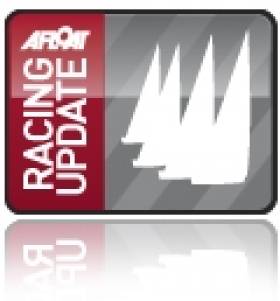Displaying items by tag: Cullaun
Small Is Beautiful As GP14s Leapfrog From April To November At Cullaun Sailing Club
The next event on the GP14 class calendar is the Munster Championships to be held at Cullaun Sailing Club in County Clare.
As regular Afloat readers will know, the event should have been its first event back in April, but postponed due to Covid precautions.
It's unclear if Shane MacCarthy and Josh Porter who in tough conditions last weekend won the Hot Toddy with some superb heavy weather sailing will travel to Clare but there is a big move on by the class to round out the year with a healthy turnout as the cartoon above depicts.
Cullaun Sailing Club Records Biggest Ever Regatta Numbers
#cullaun – Cullaun Sailing Club in East Clare held their Annual September Regatta last weekend which was the busiest they have ever experienced. They had an open regatta with 27 Boats on the water on Saturday and 21 on Sunday. It was a very good sailing and social weekend with Visitors from Killaloe Sailing Club, East Down Yacht Club, Greystones and Ramor Watersports in Cavan. There were perfect wind conditions for the sailors on Saturday and changing to very light conditions on Sunday.
There was no disputing the outright Winner being Monica Schaefer with 4 firsts out of Seven races. She was followed closely by Henry O Freill in second Place followed by Trevor Fisher in third. Margaret Hynes and Michael Hayes were the best Cullaun Club boat over the two days followed by Brian Parks and Chris Caher. They had a mixture of Wayfarers, Enterprises, RS 400, RS200, Lasers and not forgetting one solitary GP14.
Our Juniors Hugh Ward and Paddy Donlon sailed very well on the Saturday but seemed to slow down a little bit on Sunday letting Mike O Dea and Sean Hynes take the lead. They were the best Juniors and excluding Trevor Fisher they were the best in the RS Fleet. The best Improver without any doubt has to go Tommy Scott who's racing skills has improved no end over the last few months.
The number of Junior Sailors that have joined the club and partaken in Easter and Summer Camps have helped raise the profile for CSC with a large number now competing at our Junior and Senior Competitions. It is great to see a lot of the familiar faces travelling large distances to come and compete at our event and we are only delighted to host such events. Cullaun Sailing Club is situated in east Clare approx. 20 minutes from Limerick and Ennis and between the two villages of Kilkishen and Tulla.
For a list of their upcoming events then take a look at www.cullaunsailingclub.com or alternatively like their facebook page at www.facebook.com/Cullaunsailingclub
Cullaun Sailing Club Hosts Wayfarer Inlands
On the weekend of the 3rd and 4th of September, Cullaun Sailing club hosted the Wayfarer Inland championships in conjunction with the club's annual mixed fleet regatta.
It was a heart lifting sight to see so many cars in the car park at Cullaun, whilst in the compound there were boats everywhere and a real buzz about the place, and was fantastic to see boats travel from East Down YC, Greystones and Killaloe sailing clubs to support the event , they really brought the event to the next level.
Registration closed at 11am and was immediately followed by the race briefing and by 11.30 the first race promptly kicked off, in all twenty boats took to the water with sailors ranging in age from eleven to seventy one, there was a nice south westerly breeze at the start of the first race, and it didn't take our visitors long to adjust to the quick wind shifts on the inland waters, in particular Tony Fisher and Simon Jeffery ( wayfarer) who set the standard for the weekend by winning the first race, the racing continued in that vein for the day.
By 5pm everyone was off the water, and after stowing the boats it was off to Donellons for a BBQ. Salads arrived in Tupperware boxes and tables laid, the adults began to unwind in the bar and chat of the days events while children picked chestnuts in the garden. As the evening turned to night the music started and the fire stoked. What a glorious day.
Sunday was a shorter day, two races with the intention of finishing at lunch time. The wind was fresh and squally early morning and the scene was set for some exciting sailing, but the wind began to ease as the racing started, Tony and Simon started day two as they had ended day one. Only in the final hour were the pair denied the perfect finish to the regatta when George Jess and Robert Anderson (Wayfarer) took the final race followed by Chris Caher (super Nova) with Fisher/Jeffery paring coming in 3rd.
Results:
Wayfarer Inland Championships
1st Tony Fisher/Simon Jeffery East Down Yacht Club
2nd George Jess/Robert Anderson East Down Yacht Club
3rd Austin Collins/Mike Laffan Cullaun Sailing Club
Best Cullaun boat
Chris Caher in 3rd place overall (Super Nova)
Enterprise Fleet
1st Colm Ward/Lelia O'Shaughnessy Cullaun Sailing Club
2nd Brian Park/Mike Logan Cullaun Sailing Club.
Thanks to all the Volunteers both on and off the water who all helped make this such a successful event, and provide the lifeblood of the club.
In Other News:
The Next event on the calendar will be the beginning of the "Cooler Series" which will start on the 11th of September at 2pm.
The September cruise is on schedule for the weekend of the 17th of September departing Kinsale, two boats and sixteen people are due to set sail, details are being circulated to all those taking part in the event.
A reminder that the laying up supper is taking place in "The Cornstore" limerick on the 26th of November, Sheila is currently taking deposits.

























































